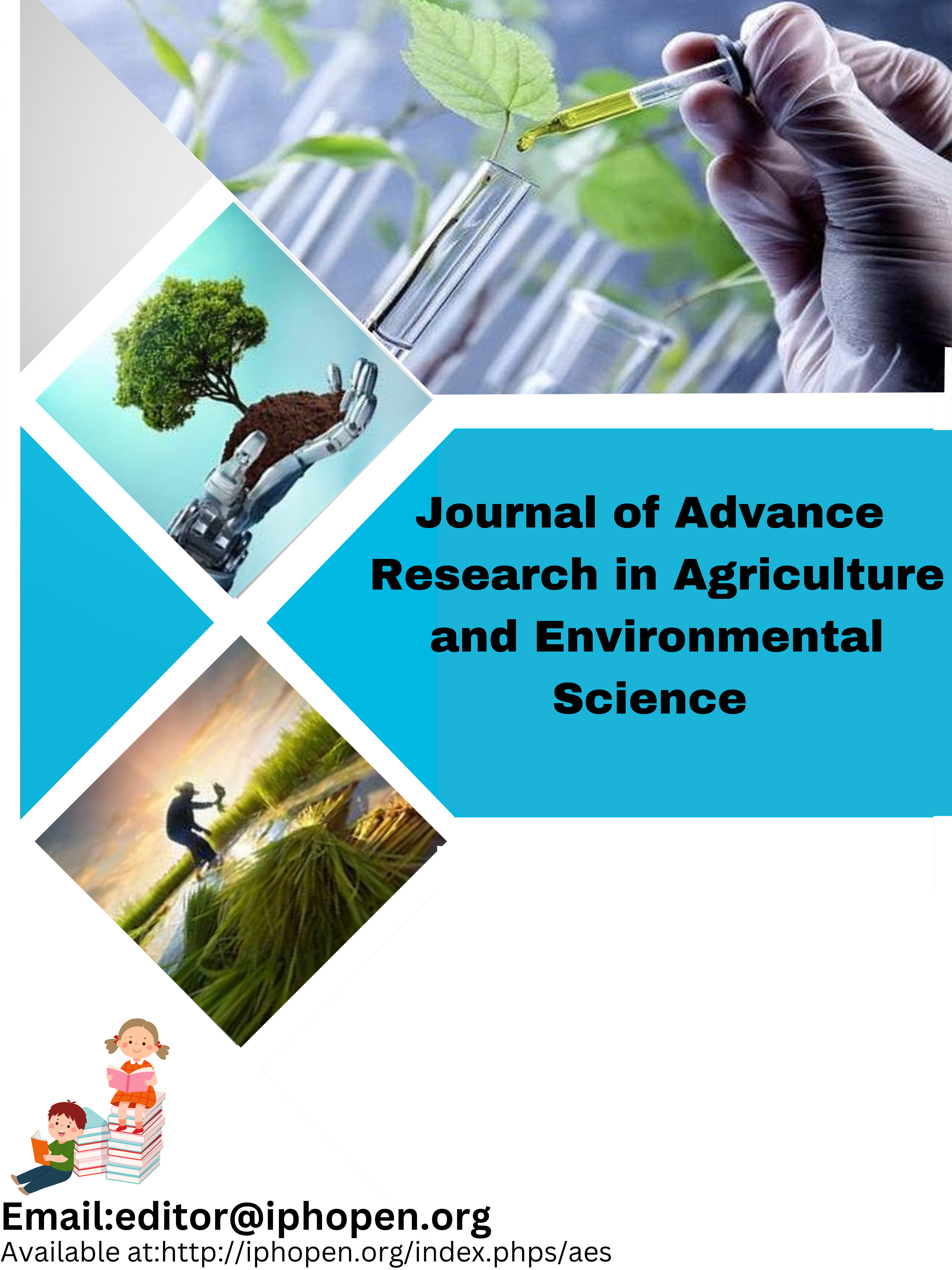ECONOMIC ANALYSIS OF SESAME PRODUCTION IN GUMA LOCAL GOVERNMENT AREA OF BENUE STATE, NIGERIA
Keywords:
Sesame, seed, Production, Profitability, ConstraintsAbstract
This study analyzed the economics of sesame production in Guma Local Government Area of Benue State, Nigeria. Data was collected from 80 respondents using structured questionnaires and analyzed using descriptive statistics, ordinary least square and gross margin analysis. The findings of the study showed that the factors affecting sesame production are farm size(0.276), farming experience(-32.135), fertilizer(0.013) and gender(0.005) which all have probability significance at P-0.05 while Age(119.512) is signinificant at P-0.01 and household size(4.762) is at P-0.10. The positive coefficients have increasing effects on the yield of sesame while the negative coefficient has a decreasing effect on sesame yield. The profitability result shows that total variable cost per hectare by sesame farmers (?147,381.00) and the total revenue (?304,560.00) yielded a gross margin of ?157,179.00 per hectare hence, sesame is a profitable venture. Inadequate funds, Lack of extension services, High cost of fertilizers, High cost of agrochemicals Were the severe constraints faced by farmers in sesame production in the study area. It was therefore recommended that Farmers be encouraged to form well-managed cooperatives or producer farmer groups and networks as avenues for accessing inputs as well as credit facilities to invest in farming, the government and research institute should make fertilizer and agrochemicals available at the right time and also at a subsidized rate.
References
Abou-Gharbia, H. A., Shehata, A. A. Y., and Shahidi, F. (2000). Effect of processing on oxidative stability and lipid classes of sesame oil.Food Res. Int.33, 331–340. doi: 10.1016/S0963-9969(00)00052-1
Aboki, E., Rukwe, D. T., Luka, P., & Nyam, C. M. (2020). Economics of sesame production among small scale farmers in southern part of Taraba State, Nigeria.Journal of Agricultural Economics, Environment and Social Sciences,6(1): 103-112.
Abu G.A., Ater, P.I. and Abah, D. (2012) Profit Efficiency among Sesame Farmers in Nasarawa State,Nigeria.Current Research Journal of Social Sciences,4(4): 261-268.
Abu, G. A., Abah, D., &Okpachu, S. A. (2011). Analysis of cost and return for sesame production in Nasarawa state: Implication for sustainable development in Nigeria.Journal of Sustainable development in Africa,13(3): 238-249.
Anilakumar, K. R., Pal, A., Khanum, F., and Bawa, A. S. (2010). Nutritional, medicinal and industrial uses of sesame (Sesamum indicumL.) seeds-an overview.Agric. Conspectus Sci.75, 159–168.
Benue State Agricultural and Rural Development Authority [BNARDA], (2011). Benue state Agricultural and Ruraldevelopment Authority.Annual report. 15-30.
Boureima, S., Eyletters, M., Diouf, M., Diop, T. A., Van Damme, P. (2011). Sensitivity of seed germination and seedling radical growth to drought stress (Sesamum indicum L.).Resource Journal of Environmental Sciences,557–564.
Bikoko-Pum, G. (2017).Etude de la rentabilité de la culture de sésame (Sesamum indicum L.) cultivée dans le groupement Kimpemba, secteur Wungu dans le Kongo Central. Kinshasa: Universite de Kinshasa,Département d'économie agricole.
Business day (2022)https://www.statista.com/statistics/1298477/sesame-seeds-production-volume-in-nigeria/. Assessed on 26 June, /2024.
City Population (2022)https://citypopulation.de/en/nigeria/admin/benue/NGA007006__guma/accessed June, 2023
UNSD (2017).UNdata. Available online at:http://data.un.org/Data.aspx?d=FAOandf=itemCode%3A289 (accessed June 26, 2024).
Doko, B. and Enwere, S. (2014). Farmer?s guide for the production and post-harvest handling of sesame products in Nigeria (TrainingMannual). STDF Project 172 co-financed by NEPC and STDF, implemented by NEPC and supervised by ITC.
Dokua D. S. (2022) Production quantity of sesame seeds in Nigeria 2010-2020https://www.statista.com/statistics/1298477/sesame-seeds-production-volume-in-nigeria. accessed June 26, 2024).
Dossa, K., Konteye, M., Niang, M., Doumbia, Y., and Cissé, N. (2017). Enhancing sesame production in West Africa's Sahel: a comprehensive insight into the cultivation of this untapped crop in Senegal and Mali.Agric. Food Secur.6, 1–15. doi: 10.1186/s40066-017-0143-3
Dudley T.S., W. James andA. Mccallum. (2000). Texas agricultural experimental station, college station.Prepared April 12, p. 125.
Financial Derivatives Company (FDC) (2018). Bio monthly Update. A financial derivatives company publication. 8 (12).
Food and Agricultural Organisation Statistics (FAOSTAT). (2013). Food and Agricultural Organisation of the United Nations Statistics Division Database. Faostat.fao.org/site/567/desktopdefault.aspx. Assessed on 6/09/2014.
FAOSTAT (2022).Production—Crops and Livestock Products. Available online at:https://www.fao.org/faostat/en/#compare(accessed August 6, 2023).
Kossivi D. F., Enete, A. A., Miassi, Y. E., & Omotayo, A. O. Economic Analysis of Sesame (Sesamum Indicum L.) Production in Northern Benin.Frontiers in Sustainable Food Systems,6, 663.
RMRDC (2004).Report on Survey of Agro Raw Materials in Nigeria: Beniseed. 1st edn. Garki-Abuja: Raw Materials Research and Development Council.
Rukwe, D. T., Aboki, E., Luka,P., & Nyam, C. M. (2020). Economics of sesame production among small scale farmers in southern part of Taraba State, Nigeria.Journal of Agricultural Economics, Environment and Social Sciences,6(1), 103-112.
Tunde-Akintunde, T. Y., Oke, M. O., and Akintunde, B. O. (2012). “Sesame Seed,” inOilseeds.InTech.Available online at:www.intechopen.com(accessed November 19, 2022).
Zerihun, J. (2012). Sesame (Sesame indicumL.) crop production in Ethiopia: trends,challenges and future prospects.Sci. Technol. Arts Res. J.1, 1–7. doi: 10.4314/star.v1i3.98793
Downloads
Published
How to Cite
Issue
Section
License
Copyright (c) 2024 IPHO-Journal of Advance Research in Agriculture and Environmental Science

This work is licensed under a Creative Commons Attribution-NonCommercial-ShareAlike 4.0 International License.
Author(s) and co-author(s) jointly and severally represent and warrant that the Article is original with the author(s) and does not infringe any copyright or violate any other right of any third parties and that the Article has not been published elsewhere. Author(s) agree to the terms that the IPHO Journal will have the full right to remove the published article on any misconduct found in the published article.







